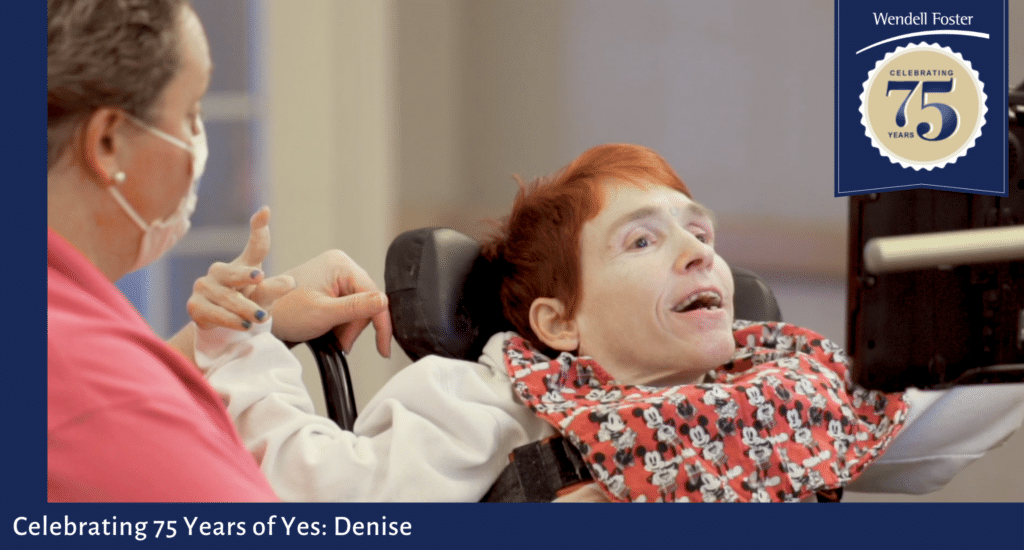By Gabby Bradley, Community Engagement Specialist, and Karissa Riter, Speech Therapist.
For 75 years, Wendell Foster has been the leader in providing Yes! moments for people with disabilities in our community. In honor of our 75th Anniversary, we are excited to spotlight the care recipients featured in our “Celebrating 75 Years of Yes!” video and share with you how they achieved their Yes! Moments at Wendell Foster. To watch our “Celebrating 75 Years of Yes!” video, click here.
Communication is an integral part of our everyday lives as human beings. We communicate to express our joys and fears, our wants and needs, and our hopes and dreams. Communication is also a key factor in socializing with others: we use communication to build relationships and grow friendships.
Communication is second nature to many of us. For as long as we can remember, we have used speech to vocalize our desires. But for people with a disability, barriers can stand in the way of being able to communicate freely with others. For some, expressing themselves cannot happen through vocalizing words. This makes a profound impact on a person’s quality of life.
Denise, a resident at Wendell Foster, is a prime example of how the power of communication can change someone’s life for the better.
Denise’s Speech Therapist, Karissa Riter, said her first introduction to Denise was in a video sent from her previous group home in Texas before she arrived at Wendell Foster. “The first thing I noticed was that Denise was in a unique wheelchair. She did not sit in a wheelchair; she lay on her stomach in a wheelchair. This created a unique challenge for positioning a communication device,” Karissa explained. “My main concern as a Speech Therapist was, ‘how does she communicate?’”
As it turns out, Denise used eye gaze to give her caregivers a yes or no response. She also had a communication book she used with her caregivers, which is a process known as partner-assisted scanning. In partner-assisted scanning, the caregiver or communication partner points and speaks the names of items in the communication book. The person with complex communication needs responds by indicating yes or no to each item to select their desired message. This was a long, arduous process that required Denise to have someone present in order to communicate. When all else failed, she would wear a headband with a laser pointer attached and point at the object that she was trying to gain.
Imagine being Denise while she was living in her previous group home. She is thirsty and wants a drink of water. First, she needs to gain someone’s attention. Remember, she cannot speak and has limited movement. Denise can vocalize, so she makes a loud noise. This gains the attention of her caregiver, and they hopefully come to see if she needs anything.
Once the caregiver arrives, Denise uses her eye gaze skills to stare at the bag hanging from her handlebars on her wheelchair to let her caregiver know she wants her communication book out of the bag to use.
Now the caregiver gets out the communication book and begins the round of 20 questions. “Do you want to talk about hygiene?” Denise looks away to indicate “no.” “Do you want to talk about activities?” Again, Denise looks away to indicate “no.” Finally, the caregiver asks, “Do you want to talk about food and drinks?” Denise looks up to indicate “yes!” After this, the caregiver goes through the list of items on the food and drink page until they finally come to the correct one.
Do you still remember what Denise wanted? This was a long, frustrating process for her. Denise wanted, and needed, a more efficient way to communicate.
“Her very first request of me when she arrived at Wendell Foster was to find her an easier way to communicate,” Karissa said.
When looking through Denise’s records, Karissa found that Denise had used a communication device many years before at her previous group home. Due to funding complications, a new device had not been purchased for her when the old one quit working. Wendell Foster’s Speech Therapy Team set out to find a device for Denise that fit her needs and abilities.
“Due to the unique wheelchair design and her limited movement, we had to get creative in looking for ways that she could access a communication device. She couldn’t just reach out, touch it, and make it talk,” explained Karissa.
A device was found for Denise that used eye gaze technology to operate the device. Eye gaze, or eye tracking, is a way of accessing a communication device using a built-in mouse that is controlled with the eyes. A built-in camera follows the eyes to see where the person is looking on the screen. The person can then select a message to communicate by looking at a button on the screen for a certain length of time.
After Denise’s caregiver placed the communication device on her wheelchair mount and turned it on, she was ready to start talking! This allowed Denise to expand her communication functions beyond yes/no questions and making choices. She could now gain attention, initiate conversations, make requests and comments, tell jokes, ask questions, participate in social routines, and describe what she sees and does. She could also share her feelings, experiences, hopes, and dreams. She could crack jokes and flirt! She could tell her nephews “I love you.” Denise had found her voice.

Denise and her Speech Therapist, Karissa Riter.
Denise used her newfound communication abilities to make a difference in her community. She started going to local elementary schools to read to children and share about her experience of living with a disability. She made friends in the community, and her self-esteem grew. Denise taught others that she is more alike than different!
Denise has continued to grow her skills and independence with continued speech, occupational, and physical therapies. Through these therapies, she has increased her strength and range of motion and is now able to sit upright in her wheelchair without pain. This increased strength and range of motion has also allowed her to move to a head tracking communication device.
Head tracking uses optical sensors to track the person’s head movements to make on-screen selections. A small, reflective dot is placed on the individual’s forehead, glasses, or other convenient spots, converting the natural movement of the head to accurately control the pointer on the screen. Using the pointer, the person dwells on the item they want to select for a certain amount of time, and the message is spoken.
Because of Wendell Foster and the determination of Karissa to find the right communication device, Denise is now experiencing the independence that comes with communication. Something as simple as changing the channel on her TV can be done with her head tracking device. She no longer has to gain the attention of another person to fulfill her needs; she now has the freedom to accomplish tasks on her own!
On the surface, Denise’s “Yes!” moment is being able to communicate easily and freely. But through her communication, Denise is also gaining independence, growing her confidence, and making her mark on the community around her. These are desires each one of us has, and Denise is no different. Thanks to the power of communication, Denise continues to achieve “Yes!” moments at Wendell Foster.
